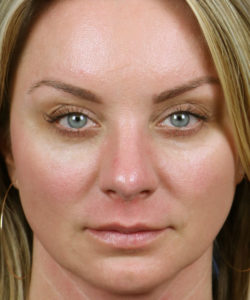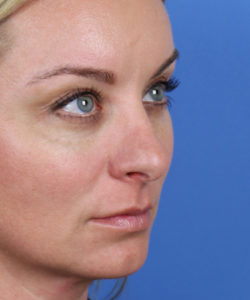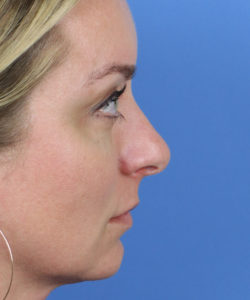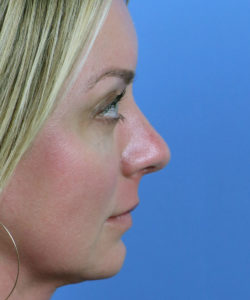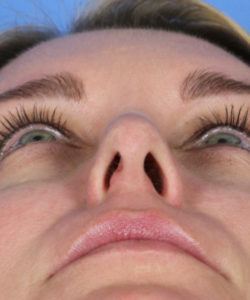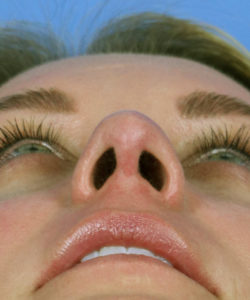This is case that involves repair of a deviated septum – called a septoplasty – but not your usual septoplasty.
Septoplasty Terminology
Some patients actually call the procedure ‘a deviated septum’ – as in they “underwent ‘a deviated septum’ last week” – but this is not a correct use of the term. Septoplasty is the more accurate term for someone undergoing surgical repair of a deviated septum. Septal reconstruction is another term used to describe this type of nose repair to improve nasal breathing.
Septoplasty Evaluation
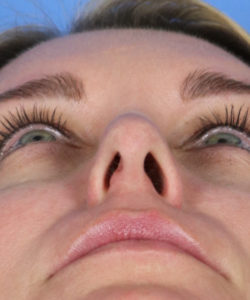
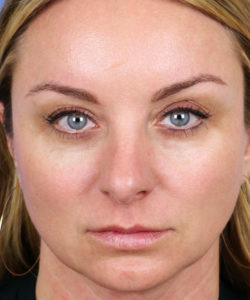 This particular patient consulted with Dr. Hilinski because of his known reputation in San Diego as one of the best septoplasty and rhinoplasty surgeons around. In fact, this patient happened to know quite a few plastic surgeons in San Diego – but chose and trusted Dr. Hilinski as her surgeon.
This particular patient consulted with Dr. Hilinski because of his known reputation in San Diego as one of the best septoplasty and rhinoplasty surgeons around. In fact, this patient happened to know quite a few plastic surgeons in San Diego – but chose and trusted Dr. Hilinski as her surgeon.
When evaluating her nose prior to surgery, you can see quite readily why she was having trouble breathing through her nose. When seen from below, her nostrils are clearly two different sizes. Now everyone has asymmetry of the nostrils – even after great plastic surgery. But hers are way off! Her right nostril is significantly smaller than her left nostril, which translated into much more difficulty breathing through this side of her nose. When seen from the front, her nose was also quite displaced. This is commonly called a crooked nose. You can see how the tip of her nose was pushed off to her right side (left in the photo). This was also a contributing factor in terms of her not being able to breathe properly through her nose.
San Diego Septoplasty Repair
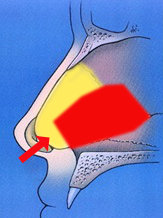 In this particular case of a deviated septum, Dr. Hilinski recommended she undergo an open technique. This means he wanted to make a cut under the nose to lift the skin up in order to repair her septoplasty. The reason behind this had to do with the location of her deviated septum.
In this particular case of a deviated septum, Dr. Hilinski recommended she undergo an open technique. This means he wanted to make a cut under the nose to lift the skin up in order to repair her septoplasty. The reason behind this had to do with the location of her deviated septum.
In most cases of septoplasty done in San Diego, the surgeon will make cuts on the inside of the nose in order to access the deviated septum. That is because most septums that are deviated are crooked further back inside the nasal cavity. The adjacent septoplasty diagram shows where most deviations are located – as indicated by the red area. Believe it or not, all of this cartilage and some bone can be removed in the red area to help improve nasal function and breathing – and the nose will stay nicely supported. That is because the yellow shaded area – called the L-strut – is still left intact, or preserved during routine septoplasty. If this yellow area is violated – or cut out during a septoplasty procedure – the patient will risk having collapse of the nose bridge and/or the nasal tip. Unfortunately, even here in San Diego there are ENT doctors who perform deviated septum surgery who accidentally cut into this L-strut of cartilage and leave patients with significant problems after routine septoplasty. But if the L-strut is minded and left intact, there should not be much of a concern of collapse following septoplasty.
In cases where the deviated septum involves any part of the yellow L-strut region (for example, where the red arrow is pointed in the adjacent diagram), a routine septoplasty will not be the appropriate surgical answer. In these types of septoplasty, the deviated septal cartilage is often times best addressed using the open rhinoplasty approach alluded to above. That is because the deviated septal cartilage has to cut out – but then replaced to help maintain an adequate L-strut. In other cases, the cartilage has to be mobilized and literally moved over and re-secured in a new location. This is best done by the open rhinoplasty approach where grafting can be done much more readily given the optimal exposure of the anatomy. This is frequently referred to as an ‘open septoplasty’ surgery. But this type of septal reconstruction is usually not performed by ENTs and otolaryngologists – largely because it requires training and experience in doing nose jobs and rhinoplasties. So more commonly this type of septoplasty is done by facial plastic surgeons who have dedicated knowledge and training in reshaping noses.
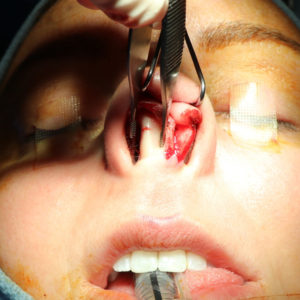 In this particular case example, her deviated septum involved the front part of the L-strut. This can be easily seen in her operative photo taken during the septal surgery performed here in San Diego by Dr. Hilinski. The outline of this L-strut area – technically called the caudal septum – can be see in between the forcep tongs in the photo. Compare the location of the septal L-strut versus where the middle of her face is – which can be roughly estimated by looking at the center of her beautiful, white teeth. You can readily see how far off of the middle this is – likely on the order of 6-7 millimeters. This is actually a good distance off in the world of septoplasty and nose reconstruction. No wonder her nostrils were so different in size and shape! And no wonder she was having trouble breathing through her nose due to the deviated septum issue.
In this particular case example, her deviated septum involved the front part of the L-strut. This can be easily seen in her operative photo taken during the septal surgery performed here in San Diego by Dr. Hilinski. The outline of this L-strut area – technically called the caudal septum – can be see in between the forcep tongs in the photo. Compare the location of the septal L-strut versus where the middle of her face is – which can be roughly estimated by looking at the center of her beautiful, white teeth. You can readily see how far off of the middle this is – likely on the order of 6-7 millimeters. This is actually a good distance off in the world of septoplasty and nose reconstruction. No wonder her nostrils were so different in size and shape! And no wonder she was having trouble breathing through her nose due to the deviated septum issue.
Ultimately, Dr. Hilinski ended up having to rebuild this entire area of her septum – including use of cartilage grafts taken from further back in her nose. But in taking the extra effort to do this type of septoplasty surgery, Dr. Hilinski was confident in being able to make her septum straighter – while also putting her nasal tip in a better esthetic position.
Open Septoplasty Results
Fast forward to her new nose created by Dr. Hilinski. The first thing you can appreciate is just how straight her nose is now – after the open septoplasty/rhinoplasty procedure. Her nose tip is now more centered on her face and her nostrils are also much more symmetrical in size and shape. On the oblique and side views, you can also see how her columella and angle of the nasal tip are improved as a result of Dr. Hilinski’s surgery. And the base view speaks for itself! Overall, this patient was quite happy with Dr. Hilinski’s septoplasty-rhinoplasty procedure – and can now breathe like a champion!

